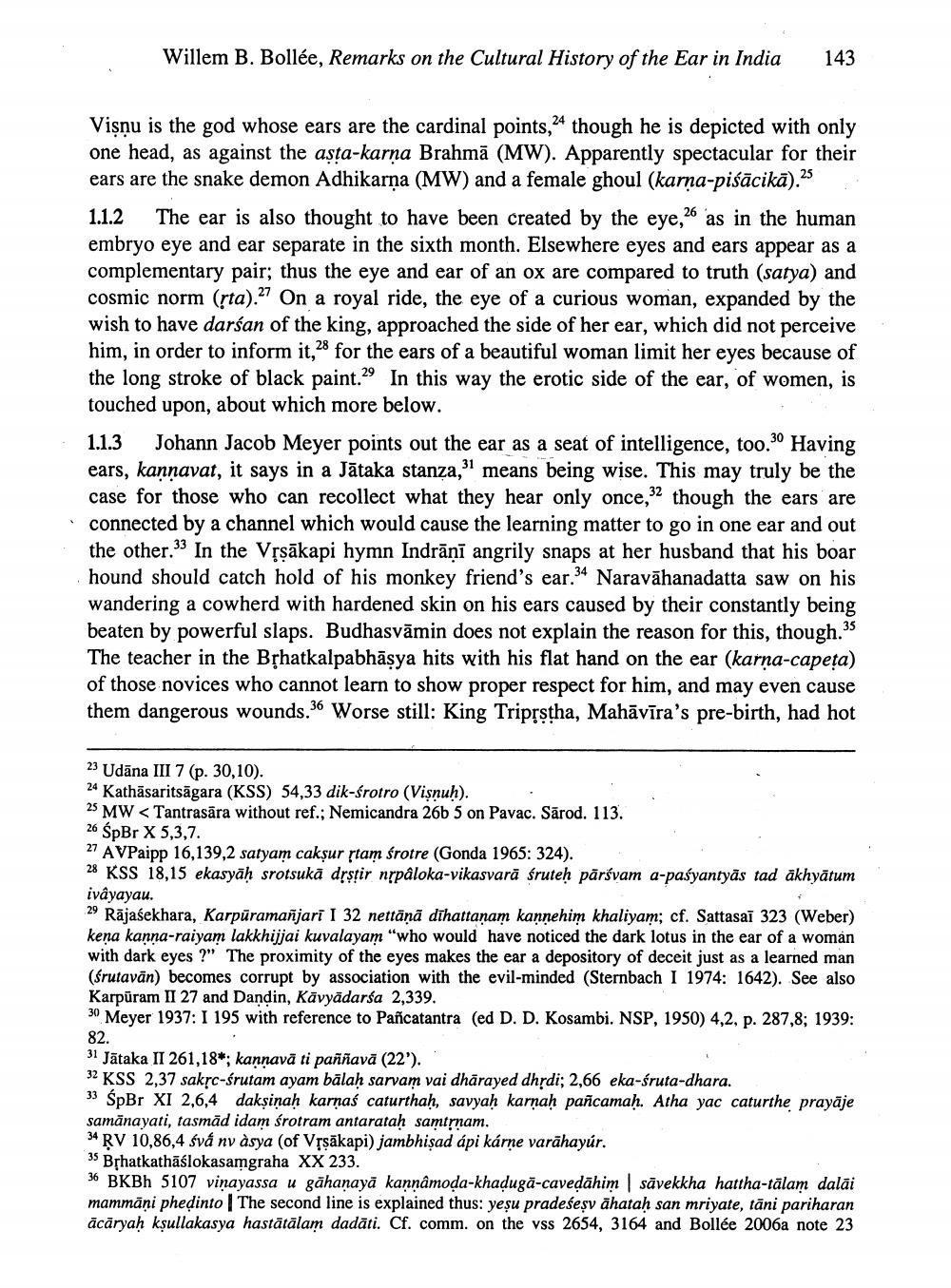________________
Willem B. Bollée, Remarks on the Cultural History of the Ear in India
143
Vişnu is the god whose ears are the cardinal points, 24 though he is depicted with only one head, as against the asta-karņa Brahmā (MW). Apparently spectacular for their ears are the snake demon Adhikarņa (MW) and a female ghoul (karna-piśācikā).25 1.1.2 The ear is also thought to have been created by the eye, 26 as in the human embryo eye and ear separate in the sixth month. Elsewhere eyes and ears appear as a complementary pair; thus the eye and ear of an ox are compared to truth (satya) and cosmic norm (rta).27 On a royal ride, the eye of a curious woman, expanded by the wish to have darśan of the king, approached the side of her ear, which did not perceive him, in order to inform it,28 for the ears of a beautiful woman limit her eyes because of the long stroke of black paint.29 In this way the erotic side of the ear, of women, is touched upon, about which more below. 1.1.3 Johann Jacob Meyer points out the ear as a seat of intelligence, too." Having ears, kannavat, it says in a Jātaka stanza," means being wise. This may truly be the case for those who can recollect what they hear only once, 32 though the ears are connected by a channel which would cause the learning matter to go in one ear and out the other. In the Vrsākapi hymn Indrānī angrily snaps at her husband that his boar hound should catch hold of his monkey friend's ear.34 Naravāhanadatta saw on his wandering a cowherd with hardened skin on his ears caused by their constantly being beaten by powerful slaps. Budhasvāmin does not explain the reason for this, though.35 The teacher in the Bșhatkalpabhāsya hits with his flat hand on the ear (karna-capeta) of those novices who cannot learn to show proper respect for him, and may even cause them dangerous wounds.36 Worse still: King Triprstha, Mahāvīra's pre-birth, had hot
23 Udāna III 7 (p. 30,10). 24 Kathāsaritsāgara (KSS) 54,33 dik-śrotro (Vişnuh). 25 MW < Tantrasāra without ref.; Nemicandra 26b 5 on Pavac. Sārod. 113. 26 ŚpBr X 5,3,7. 27 AVPaipp 16,139,2 satyam cakşur stam śrotre (Gonda 1965: 324). 28 KSS 18,15 ekasyāh srotsukā drsțir nrpaloka-vikasvarā śruteh pārívam a-paśyantyäs tad ākhyātum ivâyayau. 29 Rājasekhara, Karpuramañjari I 32 nettāņā dīhattanam kannehim khaliyam; cf. Sattasai 323 (Weber) kena kanna-raiyam lakkhijjai kuvalayam "who would have noticed the dark lotus in the ear of a woman with dark eyes ?" The proximity of the eyes makes the ear a depository of deceit just as a learned man (śrutavān) becomes corrupt by association with the evil-minded (Sternbach I 1974: 1642). See also Karpūram II 27 and Dandin, Kävyādarśa 2,339. 30 Meyer 1937: I 195 with reference to Pañcatantra (ed D. D. Kosambi. NSP, 1950) 4,2, p. 287,8; 1939:
82.
31 Jataka II 261,18%; kannavã ti paññavã (22'). 52 KSS 2,37 saksc-śrutam ayam bālaḥ sarvam vai dhārayed dhrdi; 2,66 eka-śruta-dhara. 33 SpBr XI 2,6,4 dakṣiṇaḥ karnaś caturthah, savyaḥ karnah pañcamah. Atha yac caturthe prayāje samānayati, tasmād idam śrotram antarataḥ samtrnam. 34 RV 10,86,4 svå nv å sya (of Vļsākapi) jambhișad api kárne varāhayúr. 35 Bịhatkathāślokasamgraha XX 233. 36 BKBh 5107 viņayassa u gāhanayā kannâmoda-khaduga-cavedāhim | sāvekkha hattha-tālam dalāi mammāņi phedinto | The second line is explained thus: yeșu pradeśeşv āhatah san mriyate, tāni pariharan ācāryah kşullakasya hastätālam dadāti. Cf. comm. on the vss 2654, 3164 and Bollée 2006а note 23




